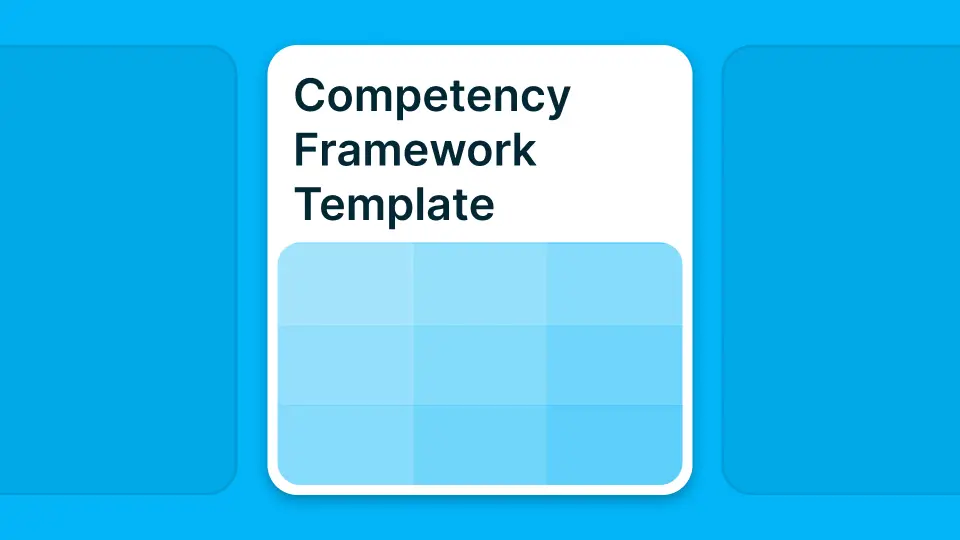Did you know that companies using a structured sales skills matrix see up to 27% faster ramp-up for new reps? If you've ever struggled to pinpoint why one AE crushes quota while another stalls—or why your SDR team seems stuck at the same proficiency level quarter after quarter—the answer often lies in visibility. Building a robust sales team isn't about luck or guesswork. It's about clarity, consistency, and a data-driven framework that maps what actually matters.
The right sales skills matrix template not only uncovers hidden talent gaps but also accelerates growth across SDRs, Account Executives, and managers. In this guide, you'll find ready-to-use templates for Excel, Google Sheets, and Notion, clear leveling rubrics anchored in real behaviors, and practical steps to make skills mapping actionable—not just another HR checkbox exercise.
Here's what you'll take away:
- Downloadable sales skills matrix templates for all key roles—from SDR through Sales Manager
- Detailed competency families including pipeline generation, discovery, objection handling, forecasting, and more
- Real-world examples from SMB to Enterprise teams
- Proficiency scales with behavior-based evidence fields to eliminate rating inflation
- Calibration tips that keep your assessments fair and consistent
Ready to build a data-driven foundation for your sales org? Let's dive into how you can use a sales skills matrix template to drive performance and clarity—without the usual headaches.
1. Building Your Sales Skills Matrix Template: Roles, Levels & Formats
A well-designed sales skills matrix template starts with clear roles and level definitions—think SDR, AE, Senior AE, Sales Engineer, and Sales Manager—mapped to real career progression. Without this foundation, you're essentially guessing which skills matter at which stage. Industry data shows organizations with standardized role matrices reduce onboarding time by 22% according to LinkedIn Talent Solutions research from 2023.
Teams using matrices aligned to defined role levels report up to 18% higher quota attainment. That's not a small margin—it translates directly to revenue and retention gains. Consider a SaaS company with global offices that used an Excel-based matrix covering SDRs through Managers. After rolling out the template company-wide, they cut ramp-up time for new AEs by two months. Their secret? Every role had explicit skill expectations tied to observable behaviors, not vague aspirations.
Here's how to set up your own template the right way:
- Define each sales role and career stage before building your matrix—don't assume everyone shares the same mental model
- Use downloadable templates in Excel or Google Sheets for flexibility and version control
- Include columns for both current skill level and target level so progression is transparent
- Make space for evidence or examples of each skill in action—this keeps ratings honest
- Provide a clear legend explaining proficiency scales so raters don't invent their own interpretations
Here's a sample structure to get you started:
| Role | Level | Core Skills | Target Level | Evidence Field |
|---|---|---|---|---|
| SDR | Entry | Prospecting | 2 | Sample call recording |
| AE | Mid | Discovery | 3 | Win/loss analysis |
| Sales Manager | Advanced | Forecasting | 4 | Team pipeline review notes |
Provide versions for Notion or collaborative tools if your team is remote or prefers real-time updates. The format matters less than clarity—pick what your reps will actually use. Now that you've got the structure nailed down, let's break down the key competency families every effective matrix should cover.
2. Core Competency Families: What Really Matters in Modern Sales
Effective matrices focus on core competency families—not just generic soft skills that apply to any role. Map out what actually drives results in each segment of the pipeline. Gartner research highlights that high-performing teams invest 30% more time developing pipeline generation and qualification skills than low-performers. That investment shows up in the numbers.
Teams prioritizing discovery and qualification outperform peers by up to 23% in deal conversion rates. If you're still treating every skill as equally important, you're leaving revenue on the table. An enterprise tech firm revamped their skills framework around MEDDIC qualification and saw forecast accuracy jump by over 15%. They stopped rewarding activity and started rewarding outcomes tied to real buyer signals.
Here's how to structure your competency families:
- Group competencies into families like prospecting, outreach, and sequencing so you can track themes not just individual skills
- Include product and industry knowledge as a core pillar—reps can't sell what they don't understand
- Map technical demo skills separately from objection handling since they require different practice loops
- Add collaboration fields for interactions with Customer Success and Marketing—cross-functional impact matters
- Don't forget ethics and compliance especially in regulated sectors like finance or healthcare
Here's a breakdown of typical competency families with example skills and evidence fields:
| Competency Family | Example Skill | Typical Evidence Field |
|---|---|---|
| Pipeline Generation | Cold outreach | Email sequence analysis |
| Discovery | Needs assessment | Call transcript review |
| Negotiation/Closing | Contract negotiation | Signed deal summary |
| Product Knowledge | Feature fluency | Demo certification test |
| Objection Handling | Pricing pushback | Recorded objection response |
Consider including MEDDIC or BANT as optional columns based on your methodology. If you run enterprise deals, MEDDIC elements like Economic Buyer identification or Champion development become critical competencies. With competencies mapped out, it's time to set up a fair proficiency scale so ratings are truly meaningful.
3. Proficiency Scales That Work: Behavior-Based Ratings & Evidence Fields
A reliable proficiency scale transforms subjective ratings into actionable insights—especially when tied to behavioral examples and concrete evidence. SHRM notes that behavior-based rating scales reduce "halo effect" bias by over 40%. That's the difference between promoting someone because they're likable versus promoting them because they've proven they can close complex deals.
Companies using behaviorally anchored scales see employee self-assessment accuracy improve by up to 33%. A mid-market B2B company switched from simple "beginner/intermediate/expert" labels to a 0–4 scale with defined behaviors. Calibration meetings became twice as fast and less contentious because everyone knew what a "3" actually meant.
Here's how to build a proficiency scale that sticks:
- Use a numeric proficiency scale like 0–4 or 1–5 so you can track progression quantitatively
- Anchor each level with observable behaviors—for instance "Can run demos solo" versus "Can shadow only"
- Add mandatory evidence fields such as deal reviews or call snippets to back up each rating
- Avoid vague terms like "good" or "strong" that mean different things to different people
- Train managers on what constitutes valid evidence so ratings stay grounded in reality
Here's a sample rubric you can adapt:
| Skill | Level Description | Behavior Example |
|---|---|---|
| Demo Skills | Level 2 – Developing | Runs demos with guidance from senior rep |
| Objection Handling | Level 4 – Expert | Coaches peers on objections and documents responses |
| CRM Hygiene | Level 1 – Basic | Updates deals weekly but misses key fields |
| Discovery | Level 3 – Proficient | Uncovers pain points independently in first call |
| Forecasting | Level 4 – Expert | Pipeline accuracy within 5% for three consecutive quarters |
Integrate evidence collection into existing CRM workflows where possible. If reps are already logging calls in Salesforce or HubSpot, pull snippets directly into your matrix instead of creating yet another data entry task. But how do you actually run these assessments—and ensure calibration across different raters?
4. Assessment Workflow & Calibration: Getting Consistent Results
Your shiny new matrix is only as good as your assessment process—consistency beats speed every time. According to Harvard Business Review, cross-team calibration reduces inflated self-ratings by nearly half. Without this step, you'll end up with a team where everyone rates themselves a "4" and nobody knows who actually needs development.
60% of organizations report more accurate promotion decisions after adding formal calibration steps to their assessment workflow. A fintech firm introduced quarterly peer calibration sessions. Within two cycles they eliminated most rating discrepancies across territories. Their sales managers finally agreed on what "exceeds expectations" looked like in practice, not just theory.
Here's how to run assessments that deliver real insights:
- Set regular assessment intervals like quarterly or bi-annually so skills data stays current
- Use multi-rater input combining manager, peer, and self-assessment perspectives
- Run calibration sessions after initial scoring where managers compare notes and align ratings
- Document rationale for score changes during calibration so the logic is transparent
- Track progress over time—not just snapshot scores—to see development trends
Here's a simple workflow to follow:
| Step | Who Involved | Frequency |
|---|---|---|
| Self-assessment | Employee | Quarterly |
| Manager review | Direct manager | Quarterly |
| Peer input | 2–3 colleagues | Bi-annually |
| Calibration | Managers and HR | Bi-annually |
| Development planning | Employee and manager | Post-assessment |
Leverage digital forms or HRIS integrations if available. Keep audit trails for transparency so employees understand how ratings were decided. If someone questions their score, you can point to specific evidence and calibration notes rather than vague impressions. So what does this look like in practice? Let's walk through real-world examples from SMBs through enterprise teams.
5. Real-Life Examples by Segment: SMB vs Mid-Market vs Enterprise Matrices
Different segments need different approaches—a one-size-fits-all template falls flat when scaling from SMB to enterprise complexity. G2 research shows that enterprise teams are twice as likely as SMBs to use advanced weighting or custom fields in their matrices. That doesn't mean SMBs should skip skill mapping altogether.
SMBs adopting basic skill matrices report up to a 20% reduction in ramp-up errors versus those without any framework in place. An SMB e-commerce company used a lightweight Google Sheets template focused on prospecting and discovery. They kept it simple—five core skills per role, a 1–3 proficiency scale, and monthly check-ins. Within six months, new SDRs hit their activity targets 30% faster.
An enterprise SaaS provider took a different approach. They layered on advanced columns like vertical expertise, weighted scores per skill family, and mandatory evidence uploads. Their matrix tracked 18 competencies across seven role levels. Complex? Yes. Necessary for a 1,200-person sales org spanning four continents? Absolutely.
Here's how complexity scales by segment:
| Segment | Matrix Complexity | Typical Columns Included |
|---|---|---|
| SMB | Basic | Role, Skill, Current Level, Target Level |
| Mid-Market | Moderate | Role, Skill Family, Current Level, Target Level, Evidence Field |
| Enterprise | Advanced | All above plus Weightings, Industry Specialization, Compliance Fields |
Choose your template complexity based on company size and resource availability:
- For SMBs start with three to five core skills per role and iterate as you grow
- For enterprises add custom columns for industry specialization or compliance needs like GDPR training
- Keep initial versions simple when starting out—you can always add layers later
- Assign an owner like an HRBP or Sales Ops lead per segment for maintenance and updates
- Regularly revisit which competencies matter most as your org evolves and markets shift
Offer downloadable sample templates tailored for each segment type. A startup selling to SMBs doesn't need the same granularity as a multinational selling into Fortune 500 accounts. Even the best-designed matrices can go wrong—let's flag common pitfalls and how you can sidestep them.
6. Common Pitfalls & How To Fix Them Fast
Most failed matrices fall victim to focusing on activities instead of outcomes—or letting everyone rate themselves a "5." Aberdeen Group found that companies who avoid activity-based metrics see up to a 19% lift in true performance improvement. The difference? Tracking "deals closed" versus "calls made." Calls matter, but only if they lead somewhere.
Inflated ratings account for over one-third of misaligned development plans in large sales orgs. A global manufacturing firm realized too late their old matrix had no outcome metrics. Inflated scores led them to promote unready reps. Switching focus to results-based competencies fixed turnover issues within two quarters.
Here's how to avoid the most common traps:
- Prioritize outcome-based measures like "closed deals" or "pipeline generated" over activity counts
- Limit self-ratings' weight unless backed by hard evidence like win/loss records or peer reviews
- Run regular reality checks via peer or manager spot audits to catch rating drift early
- Train raters on unconscious bias and rating inflation signals so they recognize when scores creep up artificially
- Refresh scoring rubrics annually based on evolving business goals and market conditions
Here's a quick reference for fixing the biggest issues:
| Pitfall | Impact | Solution |
|---|---|---|
| Activity focus | Misleading development plans | Switch to outcome KPIs like revenue or win rate |
| Inflated self-ratings | Promotion errors | Multi-rater calibration with manager override |
| Outdated competencies | Skill gaps persist | Annual rubric refresh tied to market trends |
| No evidence fields | Subjective ratings | Mandatory evidence uploads for all scores above 3 |
| Inconsistent raters | Team friction | Quarterly calibration sessions with documented rationale |
Use resources like performance review templates and skill gap analysis templates for remediation strategies. If you catch these issues early, they're easy to fix. Wait too long, and you'll spend months rebuilding trust in your entire assessment process. Curious how next-gen tools can supercharge all this? Let's peek at AI-driven solutions shaping the future of skill management.
7. Using Sprad's Atlas AI & Skills Taxonomy For Smarter Matrices
Leveraging AI isn't science fiction anymore—the right tech helps you map relevant skills faster and spot gaps before they hurt your numbers. According to Deloitte's Human Capital Trends Report, AI-powered talent management improves gap detection accuracy by up to 45%. That's the difference between guessing where to invest training dollars and knowing exactly which skills move the revenue needle.
Sprad's Atlas AI covers over 32,000 unique sales-relevant skills—compared with roughly 800 typically mapped manually at large firms. A global logistics provider plugged Sprad's taxonomy into their own Notion-based matrix. Gap summaries generated automatically improved manager coaching conversations within weeks. Instead of spending hours combing through spreadsheets, managers got instant visibility into which reps needed help with discovery versus negotiation.
Here's what AI-powered skill mapping brings to the table:
- Tap into pre-built taxonomies covering thousands of nuanced sales skills from cold outreach to enterprise contract negotiation
- Use AI suggestions when creating new competency frameworks or updating old ones so you don't miss emerging skills
- Summarize team-wide gaps instantly instead of manual spreadsheet comb-throughs that take days
- Visualize strengths and weaknesses at individual and group level effortlessly with real-time dashboards
- Integrate outputs directly into existing HRIS or performance systems for seamless workflow continuity
Here's how AI stacks up against traditional manual mapping:
| Method | Skills Mapped | Update Frequency | Gap Detection Speed |
|---|---|---|---|
| Manual Spreadsheet | ~800 | Annually | Days to weeks |
| Sprad Atlas AI | 32,000+ | Continuous/Real-time | Instant |
When you're managing a sales org with dozens of reps across multiple regions, automation stops being a nice-to-have and becomes essential. Atlas AI doesn't just save time—it surfaces insights you'd never catch manually. For hands-on guides check the Skill Management pillar.
Conclusion: Data-Led Sales Skills Matrices Drive Real Change
A tailored sales skills matrix template accelerates onboarding and boosts quota achievement across roles. When you map the right competencies to the right levels—and back them up with real evidence—you stop guessing and start leading with data. Focusing on behavior-based ratings with evidence fields reduces bias and clarifies development needs. No more arguments about who deserves promotion. The numbers tell the story.
Regular calibration plus smart tech like Atlas AI ensures your frameworks stay relevant as markets shift. The sales skills that mattered three years ago aren't necessarily the ones that will drive revenue next quarter. Stay agile, keep measuring, and let your matrix evolve with your team.
Here's what to do next:
- Download the right template version for your org size—whether that's a basic Google Sheet or a comprehensive Excel workbook with weighted scoring
- Convene a cross-functional group to define key competencies per role—don't let HR do this in a vacuum
- Pilot your first round of assessments and schedule follow-ups every quarter to track progress over time
As remote work reshapes global selling and new products emerge monthly, expect smarter matrices driven by continuous data flows and integrated AI recommendations to become table stakes rather than extras. The organizations that invest now will be the ones closing deals faster and retaining top talent longer.
Frequently Asked Questions (FAQ)
What is a sales skills matrix template and why does my team need one?
A sales skills matrix template is a structured tool that maps required competencies against specific roles such as SDRs or AEs. It helps visualize skill gaps at both individual and team levels so leaders can prioritize training efforts efficiently. Without one, you're essentially flying blind—promoting people based on gut feel instead of proven capabilities. Teams using skill matrices report faster ramp-up times, higher quota attainment, and clearer career paths. If you're serious about building a high-performing sales org, a matrix isn't optional—it's foundational.
How do I build an effective sales skills matrix from scratch?
Start by defining all relevant roles and listing key competencies per role family like discovery or negotiation. Assign clear proficiency levels with behavior examples so everyone knows what a "3" versus a "4" looks like in practice. Include space for evidence like call reviews or deal summaries to back up ratings. Use a simple numeric scale—0 to 4 or 1 to 5 works well—and avoid vague terms like "good" or "strong." Pilot your matrix with one team before rolling it out company-wide. Gather feedback, iterate, and make sure it's actually getting used—not just sitting in a Google Drive folder nobody opens.
Which role levels should be included in my sales skills matrix?
For comprehensive coverage include SDRs or junior reps through Account Executives and Senior AEs up to Sales Engineers and Sales Managers. Adapt based on your organization chart—if you have specialized roles like Sales Development Representatives or Customer Success Managers who touch the sales process, add them too. The goal is to map every role that directly impacts revenue generation. Enterprises might also add columns for vertical specialization or regional expertise. SMBs can start simpler with just SDR, AE, and Manager levels and expand as the team grows.
How often should I assess my team using the matrix?
Best practice is quarterly assessments paired with biannual calibrations. This keeps data fresh while allowing time for development actions between reviews. Monthly assessments can overwhelm managers and turn into checkbox exercises. Annual reviews leave too much time for drift—skills gaps go unaddressed and top performers lose momentum. Quarterly cadence strikes the right balance. Run self-assessments first, then manager reviews, then peer input if you have bandwidth. Follow up with calibration sessions where managers compare notes and align ratings to avoid inconsistency across teams.
What are common mistakes when using a sales competency framework?
The biggest pitfalls are focusing only on activities instead of measurable outcomes—and letting everyone rate themselves too highly without real-world proof. If your matrix tracks "number of calls made" rather than "deals closed" or "pipeline generated," you're measuring effort not impact. Inflated self-ratings derail promotion decisions and waste training budget on the wrong people. Other mistakes include outdated competencies that don't reflect current market needs, inconsistent raters who apply different standards, and no mandatory evidence fields to back up scores. Fix these fast or your matrix becomes just another HR artifact nobody trusts.












